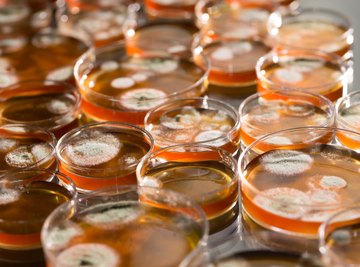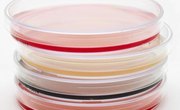
Penicillin is a group of widely used antibiotics derived from Penicillium mold. In 1928, British scientist Alexander Fleming was working with a staphylococcus culture when he observed that colonies growing near a contaminating mold looked strange. He believed the mold may have been releasing a substance that killed the bacteria. It was studied further and penicillin was discovered. Penicillin is used to treat gram-positive bacterial infections by inhibiting the bacteria's cell wall synthesis, thus weakening and killing it in the process. It can easily be grown for a science project because it is obtained from mold.
- Slice of bread
- 750ml flask
- Several glass bottles
- Cold water
- Science lab kit containing:
- 44 grams lactose monohydrate
- 25 grams cornstarch
- 3 grams sodium nitrate
- 0.25 grams magnesium sulfate
- 0.5 grams potassium phosphate mono
- 2.75 grams glucose monohydrate
- 0.044 grams zinc sulfate
- 0.044 grams manganese sulfate
- Hydrochloric acid
Don't ingest homemade penicillin--it can be contaminated by other mold spores.
Set up a penicillin culture by leaving a slice of bread at room temperature. Wait and observe until a greenish mold forms.
Preheat oven to 315 degrees Fahrenheit. Sterilize the flask by putting it in the oven for one hour. Clean the glass bottles thoroughly. Store in a refrigerator for up to 10 days if not using immediately.
Cut the molded bread into tiny pieces. Insert them into the flask. Place a flask in a dark area and let it sit at room temperature for five days.
Add liquid lab ingredients to 16.9 ounces of cold water. The lab ingredients should be dissolved in the order listed. Add cold water until the total amount of liquid reaches one liter. Adjust the pH with hydrochloric acid until it is between 5.1 and 5.4.
Add liquid to glass bottles. Make sure there is the right amount of liquid in a bottle by placing it on its side. The bottle plug should not come in contact with the liquid.
Add 1 tablespoon of bread spores. Lay bottles on their side.
Leave the bottles on their sides for one week. Keep them at room temperature. Do not disturb the bottles. If penicillin propagation was successful, it will be present in the liquid. Refrigerate right away for further classroom use.
Things You'll Need
Warnings
References
Warnings
- Don't ingest homemade penicillin--it can be contaminated by other mold spores.
About the Author
Delialah Falcon has been writing professionally for eight years. With extensive experience in all aspects of both technical and creative writing, Falcon specializes in content writing, research, proofreading/editing and health/medical journalism. She is currently pursuing a Bachelor of Arts in English from Dowling College and a Bachelor of Science and Master of Science in holistic nutrition from Clayton College of Natural Health.
